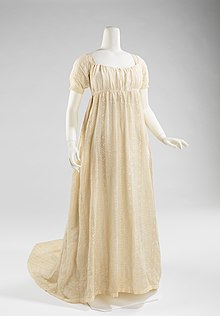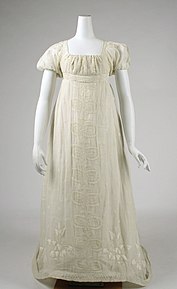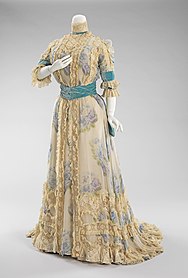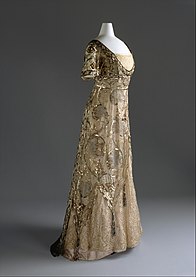Dress
A dress (also known as a frock or a gown) is a garment traditionally worn by women or girls consisting of a skirt with an attached bodice (or a matching bodice giving the effect of a one-piece garment).[1] It consists of a top piece that covers the torso and hangs down over the legs. A dress can be any one-piece garment containing a skirt of any length, and can be formal or casual.
A dress can have sleeves, straps, or be held up with elastic around the chest, leaving the shoulders bare. Dresses also vary in color.
The hemlines of dresses vary depending on modesty, weather, fashion or the personal taste of the wearer.[2]
Overview
Dresses are outer garments made up of a bodice and a skirt and can be made in one or more pieces.[3][4] Dresses are generally suitable for both formal wear and casual wear in the West for women and girls.[4]
Historically, dresses could also include other items of clothing such as corsets, kirtles, partlets, petticoats, smocks, and stomachers.[5][6][7]
History
11th century
In the 11th century, women in Europe wore dresses that were similar to men's tunics and were loose, with a hemline reaching to below the knees or lower.[8] By the end of the century, these dresses featured a tighter fit on the arms and women's upper bodies.[8] Dresses were made snug by featuring slits on the sides of the dress that were pulled tight in order to fit a woman's figure.[9]
16th century
Starting in the 1550s, middle- and upper-class women in Europe wore dresses which included a smock, stays,
Women's dresses in Russia during both the 16th and 17th centuries identified a woman's place in society or their family.[13]
17th century
Holland, as a center of textile production, was a particularly noted area of innovation in dress fashion during the 17th Century.[7] In Spain and Portugal, women wore stomachers [7] while in England and France, dresses became more "naturally" shaped.[7] Lace and slashing were popular decorations.[7] Skirts were full, with regular folds and the overskirt allowed the display of an underskirt of contrasting fabric.[7] Necklines became lower as well.[7] Embroidery that reflected scientific discoveries, such as newly discovered animals and plants were popular.[14] In the British Colonies, multi-piece dresses were also popular, though less luxurious.[15] Wealthy women living in the Spanish or Dutch colonies in the Americas copied the fashions that were popular from their homelands.[16]
The three-piece dress, which had a bodice, petticoat and gown, was popular until the last 25 years of the century, in which the mantua, or a one-piece gown, became more popular.[17] Corsets became more important in dresses by the 1680s.[18]
Working women, and women in slavery in the Americas, used simple patterns to create shifts, wool or linen petticoats and gowns and cotton dresses.[19] The bottoms of the skirts could be tucked into the waistband when a woman was near a cooking or heating fire.[19]
18th century

Large, triangular silhouettes were favored during the 18th century, skirts were wide and supported by hoop underskirts.[20][21] One-piece gowns remained popular until the middle of the century.[22] During the 1760s in France, hoop petticoats were reduced in size.[23] Lighter colors and lighter fabrics were also favored.[24] In Colonial America, women most often wore a gown and petticoat, in which the skirt of the gown opened to reveal the petticoat underneath.[25] Women also had riding habits which consisted of the petticoat, jacket and a waistcoat.[25]
French fashion regarding dresses became very fast-changing during the later part of the 18th century.
19th century

Women's dresses in the 19th century began to be classified by the time of day or purpose of the dress.[30] High-waisted dresses were popular until around 1830.[30]
Early nineteenth century dresses in Russia were influenced by Classicism and were made of thin fabrics, with some semi-transparent.[31] Elizabeth Vigée Le Brun wore these types of dresses with a short skirt (reaching to her ankles) when she lived in Russia between 1785 and 1801[31] and many Russian women copied her style.[31] By the 1840s, Russian women were turning to what was in fashion in Europe.[32]
Europeans styles in dresses increased dramatically to the
To sleep, women in the American West wore floor-length dresses of white cotton with high collars displaying decoration.[35] Various Native American people, such as the Navajo and the Mescalero Apache began to adapt the designs of their dresses to look more like the European Americans they came in contact with.[36] Navajo women further adapted the European designs, incorporating their own sense of beauty, "creating hózhó."[37]
Paper sewing patterns for women to sew their own dresses started to be readily available in the 1860s, when the Butterick Publishing Company began to promote them.[38] These patterns were graded by size, which was a new innovation.[39]
The Victorian era's dresses were tight-fitting and decorated with pleats, rouching and frills.[28] Women in the United States who were involved in dress reform in the 1850s found themselves the center of attention, both positive and negative.[40] By 1881, the Rational Dress Society had formed in reaction to the restrictive dress of the era.[28]
20th century

In the early twentieth century, the look popularized by the Gibson Girl was fashionable.[41] The upper part of women's dresses in the Edwardian era included a "pigeon breast" look that gave way to a corseted waist and an s-shaped silhouette.[41] Women called their dresses "waists" if one-piece, or "shirtwaists," if it consisted of a skirt and a blouse.[42] The bodice of the dresses had a boned lining.[42] Informally, wealthy women wore tea gowns at home.[43] These garments were looser, though not as loose as a "wrapper," and made of expensive fabric and laces.[43]
By 1910, the Edwardian look was replaced with a straighter silhouette.[44] French designer, Paul Poiret, had a huge impact on the look of the time.[44] Designs developed by Poiret were available in both boutiques and also in department stores.[45] Popular dresses of the time were one-piece and included lingerie dresses which could be layered.[46] At around the same time, in the United States, the American Ladies Tailors' Association developed a dress called the suffragette suit, which was practical for women to work and move around in.[47][48] Another innovation of the 1910s was the ready availability of factory-made clothing.[49]
Waistlines started out high and by 1915 were below the natural waist.[46] By 1920, waistlines were at hip-level.[46] Between 1910 and 1920 necklines were lower and dresses could be short-sleeved or sleeveless.[50] Women who worked during World War I preferred shorter dresses, which eventually became the dominant style overall.[24] In addition to the shorter dresses, waistlines were looser and the dominant colors were black, white and gray.[51]
By 1920, the "new woman" was a trend that saw lighter fabrics and dresses that were easier to put on.[52] Younger women were also setting the trends that older women started to follow.[52] The dresses of the 1920s could be pulled over the head, were short and straight.[53] It was acceptable to wear sleeveless dresses during the day.[53] Flapper dresses were popular until end of the decade.[54]
During World War II, dresses were slimmer and inspired by military uniforms.[28] After WWII, the New Look, promoted by Christian Dior was very influential on fashion and the look of women's dresses for about a decade.[55]
Since the 1970s, no one dress type or length has dominated fashion for long, with short and ankle-length styles often appearing side by side in fashion magazines and catalogs.[56]
Use
| Part of a series on |
| Western dress codes and corresponding attires |
|---|
|
Legend:
Contents/Culture and the arts portal |
In most varieties of
Formal dress
In western countries, a "formal" or
Basic dress
A basic dress is a usually dark-colored dress of simple design which can be worn with various accessories to suit different occasions.[58] Different kinds of jewelry, belts, scarves, and jackets can be worn with the basic dress to dress up or down.[59] A little black dress is an example of a basic dress.
Bodycon dress


A bodycon dress is a tight figure-hugging dress, often made from stretchy material.[60] The name derives from "body confidence"[61] or, originally, "body conscious", transformed into Japanese in the 1980s as "bodikon".
Party dress

A party dress is a dress worn especially for a
Types of dresses
Time period
-
16th century dress.
-
Calico dress, c. 1656–1693
-
Late 17th century, wool and metallic thread.
-
Russian dress, 1717
-
Dress c. 1750–1800, wool and chintz.
-
Dress c. 1770–1800, chintz and printed cotton
-
Classic empire line gown, muslin with tambour, c. 1805
-
Dress and outfit, c. 1855
-
Late 19th century
-
Silk velvet, chenille and chiffon created by Jean-Philippe Worth, 1903
-
Rayon with seed beads, c. 1925
-
Dance dress, 1939
-
Day dress, c. 1940s
-
Lola Beer Ebner in "afternoon dress", 1950
-
Blue satin cocktail dress, 1959
-
Printed dress, c. 1960
-
Jersey dress, c. 1970
Lengths
-
Gown or Long Dress – a woman's formal dress, usually having a floor-length skirt.[66]
-
Midi dress – a "midi" is used to refer to any dress or skirt that has a hem which hits at mid-calf – halfway between the knee and ankle.[66]
-
Knee length dress – Hemline ends at knee height.[66]
-
Micro dress (right) with minidresses, 2008. – A microdress is an extremely short version of a mini.[69]
See also
- China poblana
- Granny dress
- History of Western fashion
- Jumper dress
- Lingerie dress
- List of individual dresses
- Mantua
- Sack-back gown (also known as robe à la française)
- Squaw dress
References
Citations
- ISBN 9780313336652.
- ^ ISBN 978-81-904575-7-6.
- ^ "The definition of dress". Dictionary.com. Retrieved 29 January 2018.
- ^ a b Picken 1957, p. 101.
- ^ a b c Edwards 2017, p. 20.
- ^ Cunningham 2003, p. 20.
- ^ a b c d e f g Edwards 2017, p. 30.
- ^ a b Newman 2001, p. 113.
- ^ Newman 2001, p. 114.
- ^ a b Edwards 2017, p. 21.
- ^ a b Bigelow 1970, p. 110.
- ^ Edwards 2017, p. 23.
- ^ Pushkareva 1997, p. 120.
- ^ Edwards 2017, p. 34.
- ^ Staples & Shaw 2013, p. 222.
- ^ Havelin 2012, p. 27.
- ^ Edwards 2017, p. 35.
- ^ Bigelow 1970, p. 126.
- ^ a b Havelin 2012, p. 26.
- ^ Bigelow 1970, p. 135.
- ^ Bigelow 1970, p. 137.
- ^ Edwards 2017, p. 49.
- ^ Pietsch 2013, p. 400.
- ^ a b "Costume". Funk & Wagnalls New World Encyclopedia. 2017 – via EBSCOhost.
- ^ a b "A Colonial Lady's Clothing: A Glossary of Terms". Colonial Williamsburg. Retrieved 24 January 2018.
- ^ Pietsch 2013, p. 397-398.
- ^ Delpierre 1997, p. 15-16.
- ^ a b c d e "A Brief History of Women's Fashion". Makers. 7 September 2016. Archived from the original on 25 January 2018. Retrieved 24 January 2018.
- ^ Bigelow 1970, p. 157.
- ^ a b Bigelow 1970, p. 183.
- ^ a b c Pushkareva 1997, p. 242.
- ^ a b Pushkareva 1997, p. 244.
- ^ Krohn 2012, p. 36.
- ^ a b Bigelow 1970, p. 188.
- ^ Krohn 2012, p. 37.
- ^ Parezo & Jones 2009, p. 384.
- ^ Parezo & Jones 2009, p. 384-385.
- ^ Darnell 2000, p. 27.
- ^ "Butterick History". Butterick Patterns. Archived from the original on 26 March 2019. Retrieved 24 January 2018.
- ISBN 9781438110332.
- ^ a b Darnell 2000, p. 9.
- ^ a b Darnell 2000, p. 11.
- ^ a b Darnell 2000, p. 13.
- ^ a b Darnell 2000, p. 49.
- ^ Darnell 2000, p. 50.
- ^ a b c Darnell 2000, p. 53.
- ^ Greenberg, Molly (1 March 2017). "100 Years of Feminist History Explained in 10 Women's Work Suits". UNC. Archived from the original on 16 October 2017. Retrieved 24 January 2018.
- ^ Khan, Sarah (16 November 2016). "The fascinating history and evolution of the female pantsuit". Marie France Asia. Retrieved 24 January 2018.
- ^ Richards 2010, p. 100.
- ^ Darnell 2000, p. 57.
- ^ Richards 2010, p. 100-101.
- ^ a b Darnell 2000, p. 73.
- ^ a b Darnell 2000, p. 77.
- ^ Darnell 2000, p. 105.
- ^ Parezo & Jones 2009, p. 383.
- ^ "The History of Hemlines". Women's History Network. 1 September 2013. Retrieved 24 January 2018.
- ISBN 978-81-8324-203-5.
- ^ "Definition of "basic dress"". Retrieved 28 July 2013.
- ISBN 978-0800758325.
- ISBN 9781782490210.
- .
- ^ "Dress Paco Rabanne 1967", Out of London, Paris, New York 1965–1968, V&A
- ISBN 978-1-902686-59-2
- ISBN 978-0-89676-202-2
- ISBN 978-1-85410-604-9
- ^ a b c d e The Vogue Sewing Book. Vogue Patterns. 1975. p. 337.
- ISBN 9780857851437.
- ISBN 9781862057647.
- ISBN 9781847887382.
General and cited references
- Bigelow, Marybelle S. (1970). Fashion in History: Apparel in the Western World. Minneapolis, Minnesota: Burgess Publishing Company. ISBN 9780808702610.
fashion in history bigelow.
- Brockmamn, Helen L.: The Theory of Fashion Design, Wiley, 1965.
- Darnell, Paula Jean (2000). From Victorian to Vamp:Women's Clothing 1900–1929. Reno, NV: Fabric Fancies. ISBN 9781887402156.
- Cunningham, Patricia A. (2003). Reforming Women's Fashion, 1850–1920: Politics, Health and Art. Kent, Ohio: The Kent State University Press. ISBN 0873387422.
- Delpierre, Madeleine (1997). Dress in France in the Eighteenth Century. Translated by Caroline Beamish. New Haven: Yale University. ISBN 9780300071283.
- Edwards, Lydia (2017). How to Read a Dress: A Guide to Changing Fashion from the 16th to the 20th Century. London: Bloomsbury Academic. ISBN 9781472533272.
- Havelin, Kate (2012). Buckskin Dresses and Pumpkin Breeches: Colonial Fashions from the 1580s to 1760s. Minneapolis: Twenty-First Century Books. p. 26. ISBN 9780761358879.
dresses.
- Krohn, Katherine (2012). Calico Dresses and Buffalo Robes: American West Fashions from the 1840s to the 1890s. Minneapolis: Twenty-First Century Bookos. ISBN 9780761380528.
- Newman, Paul B. (2001). Daily Life in the Middle Ages. Jefferson, North Carolina: McFarland & Company, Inc. ISBN 9780786408979.
- Parezo, Nancy J.; Jones, Angelina R. (June 2009). "What's in a Name?: The 1940s–1950s 'Squaw Dress'". S2CID 162233209.
- Picken, Mary Brooks (1957). The Fashion Dictionary: Fabric, Sewing, and Dress as Expressed in the Language of Fashion. New York: Funk & Wagnalls Company.
- Pietsch, Johannes (September 2013). "On Different Types of Women's Dresses in France in the Louis XVI Period". Fashion Theory: The Journal of Dress, Body & Culture. 17 (4): 397–416. S2CID 191612745.
- Pushkareva, Natalia (1997). Women in Russian History: From the Tenth to the Twentieth Century. Translated and edited by Eve Levin. Armonk, New York: M.E. Sharpe. ISBN 9780765632708.
- Richards, Marlee (2010). America in the 1910s. Minneapolis: Twenty-First Century Books. ISBN 9780822534372.
- Staples, Kathleen A.; Shaw, Madelyn (2013). Clothing Through American History: The British Colonial Era. Santa Barbara, California: Greenwood. ISBN 9780313084607.
- Stoykov, Lubomir (2016). Theoretical Problems of Fashion. Sofia: National Academy of Art. ISBN 978-954-9799-11-8.
- Tozer, Jane, and Sarah Levitt: Fabric of Society: A Century of People and Their Clothes 1770–1870, Laura Ashley Ltd., 1983; ISBN 0-9508913-0-4.
External links
 Media related to Dresses at Wikimedia Commons
Media related to Dresses at Wikimedia Commons














![Silk velvet, chenille and chiffon created by Jean-Philippe Worth [nl], 1903](http://upload.wikimedia.org/wikipedia/commons/thumb/f/f9/1903_purple_velvet_afternoon_dress_by_the_House_of_Worth.jpg/80px-1903_purple_velvet_afternoon_dress_by_the_House_of_Worth.jpg)







![Gown or Long Dress – a woman's formal dress, usually having a floor-length skirt.[66]](http://upload.wikimedia.org/wikipedia/commons/thumb/c/c8/Maria_Grazia_Cucinotta_-_nicogenin_-_66%C3%A8me_Festival_de_Venise_%28Mostra%29_2.jpg/80px-Maria_Grazia_Cucinotta_-_nicogenin_-_66%C3%A8me_Festival_de_Venise_%28Mostra%29_2.jpg)
![Maxi dresses (c. 1970) – maxi is a term used since the late 1960s[67] for ankle-length, typically informal dresses.[66]](http://upload.wikimedia.org/wikipedia/commons/thumb/c/c3/Electric_blue_maxi_dress_with_cognac_accessories.jpg/74px-Electric_blue_maxi_dress_with_cognac_accessories.jpg)
![Midi dress – a "midi" is used to refer to any dress or skirt that has a hem which hits at mid-calf – halfway between the knee and ankle.[66]](http://upload.wikimedia.org/wikipedia/commons/thumb/4/41/Fabiana_Semprebom2.jpg/90px-Fabiana_Semprebom2.jpg)
![Knee length dress – Hemline ends at knee height.[66]](http://upload.wikimedia.org/wikipedia/commons/thumb/2/21/5-promotional-models-fenasucro.JPG/80px-5-promotional-models-fenasucro.JPG)
![Mini dress (1960s) – a very short dress that terminates above the knee.[66][68]](http://upload.wikimedia.org/wikipedia/commons/thumb/3/33/Alexis_Texas_at_Sexpo_in_Sydney%2C_Australia_04.jpg/80px-Alexis_Texas_at_Sexpo_in_Sydney%2C_Australia_04.jpg)
![Micro dress (right) with minidresses, 2008. – A microdress is an extremely short version of a mini.[69]](http://upload.wikimedia.org/wikipedia/commons/thumb/9/92/Glamour_Models_on_Red_Carpet.jpg/80px-Glamour_Models_on_Red_Carpet.jpg)